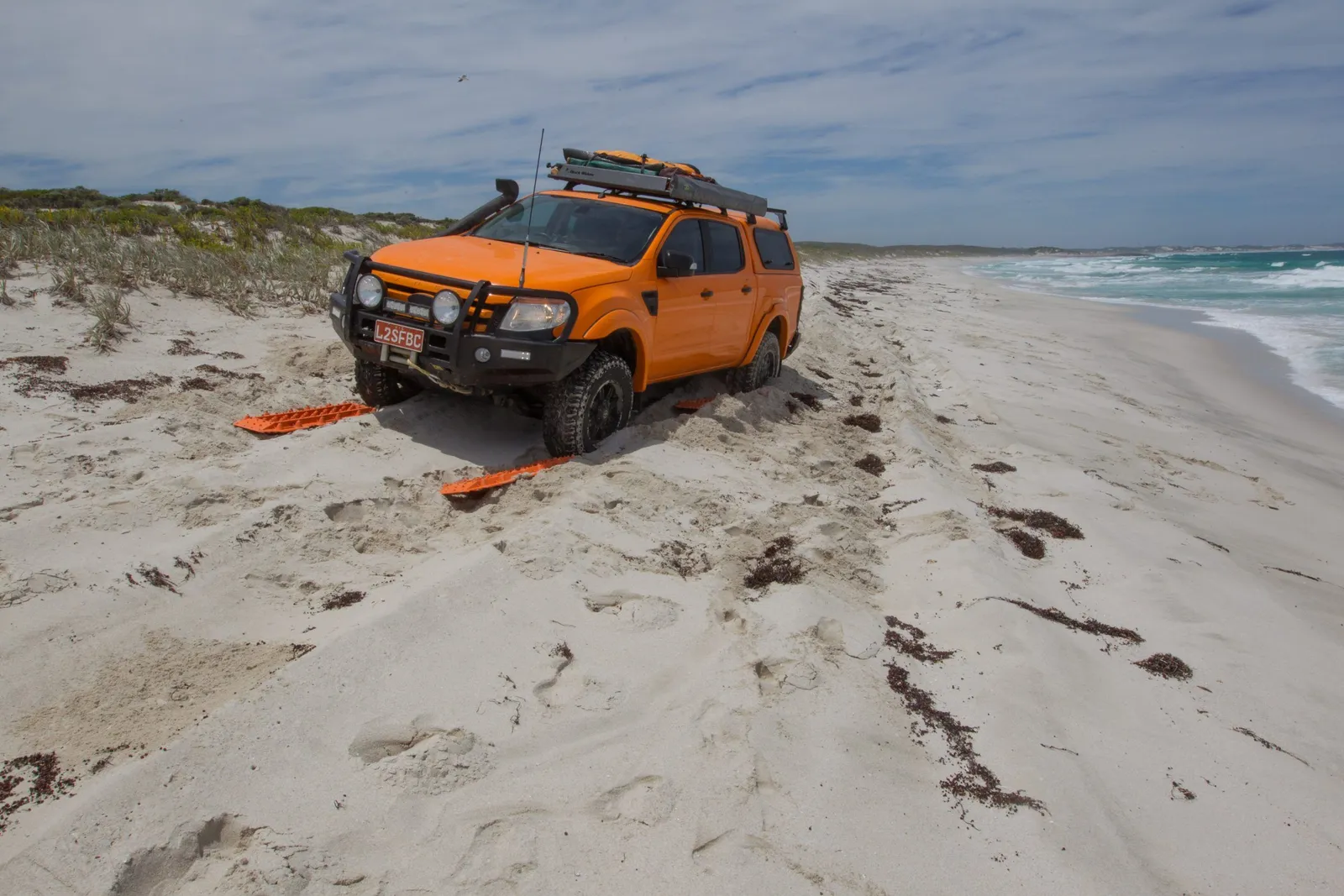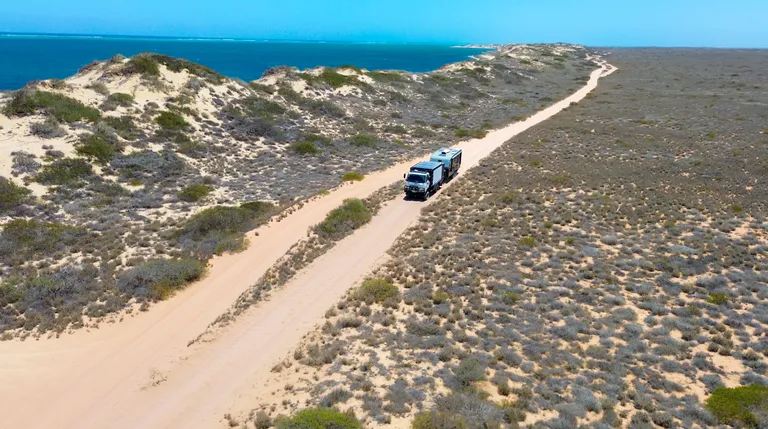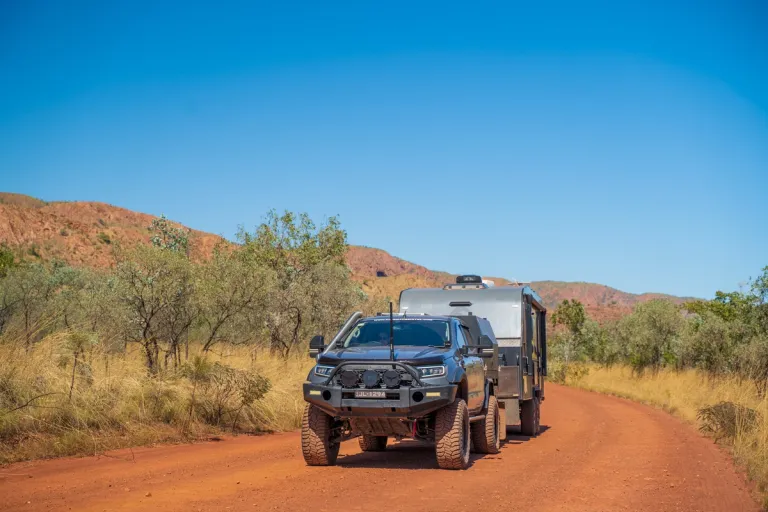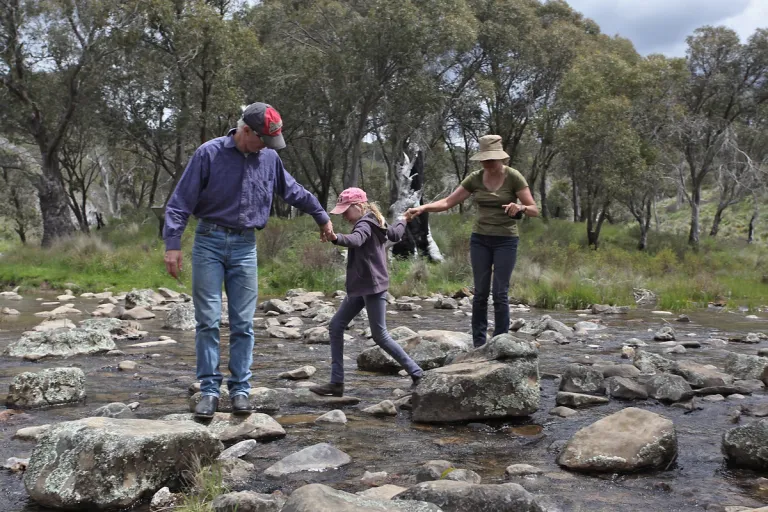Bogging your vehicle when you’re in the bush on your own can be a little scary. Keep calm and read our guide to 4X4 solo recovery tips.
Article from Unsealed 4X4
It’s true that whether you’re alone or with a group, a winch is a winch and a shovel is a shovel. But that doesn’t mean to say being alone is the same as with a group. I think there’s major differences between the two, and that starts with the golden rule of recovery.
First, keep safe. That becomes a lot more difficult when you’re alone, as there will be nobody to assist you in the event of an accident, and you’re more likely to take risks, doing things with one person that would normally take two.
You’ll also have fewer options when you’re solo. No other vehicle can snatch you, or winch you, and being assisted by another vehicle is very common in recoveries. But you may have more options than you initially think, you’ll just need to work harder to think of them and make them work. And there will be nobody to help think of ideas. There will also be nobody to help as a guide or second set of eyes. How far can you edge forwards? Or back? What exactly is happening under your vehicle? Nobody to tell you as you drive. Again, that increases the difficulty level.
All this means that you actually need to shift your mindset when you’re solo-stuck, and your first difficult solo recovery can come as a bit of a mental shock. You realise just how far away you are from help, and it’s just you to deal with the situation. Here’s how you handle it.
The first thing to do is slow down your thinking. Right down, for lots of reasons. First, solo recoveries are difficult enough and you don’t want to make them any harder by making a bad situation worse, and we all know that’s easy to do. Second, you’re just one person, with limited amounts of strength and energy. There’s nobody to hand a shovel to for their turn. And third, as solo recoveries are more difficult, they need more planning, and that means time. You may be panicking a little, and that never leads to good decisions. Fourth, there’s nobody to bounce ideas off, so you need to tell yourself your first idea isn’t great and not get mentally locked into the first thing you think of.
My very strong advice, having been solo bogged more than a few times, is to get out of the vehicle, chill, relax and consider the situation for a solid five minutes or more.
You then need to follow the standard 4X4 recovery process, but very methodically, and slowly because of all the reasons above – safety, not making it worse, and limited options.
The first thing to do is to figure out why you’re stuck, and where you need to go. You may be hung up on your diffs or underbody, unable to drive up a hill…take a long, hard look at the car from all around. Don’t think about solutions just yet. Simply absorb what you see.
Next, figure out what gear you have. Obviously things like winches, traction ramps and Bog Outs may be useful. And you’d think no way would a snatch strap be of any use…but don’t put it out of your mind entirely. When you’re solo bogged, everything is an option. Your vehicle’s jack, floor mats, even camping gear might all be useful, as can be a chainsaw which can be used to make wood tools, or remove undergrowth. Make an inventory of the car and contents.With your gear inventoried, you’re then at the point where you can start to figure out recovery options. In an article like this, I can’t be very specific as there’s just so many different ways to get stuck and recover, but I can offer some general advice from experience.
- Tyre pressures. You were probably at 20 or above when you were stuck. In almost every case, dropping down to 12 or so will help. The exception is when you really need clearance, and traction isn’t a problem such as hard rock, but even then, lower is probably better.
- Dig and move. Most of the time, a 4X4 can be de-bogged by lots of digging or earthmoving. You’ve got a spade, so use. No spade? Can you use a stick? Lack of proper digging means you may not get out, or make it worse. If it takes two hours, so be it. Solo recovery is typically slower than group recovery.
- Give up early. It’s tempting, but don’t sit there spinning wheels as that just makes things worse, increasing the time it’ll take to get out.
- Evaluate what’s happening. Is it helping? Is there a chance of success? This is hard to do when solo, as there’s nobody else to tell you otherwise.
Here’s some out-of-the-box ideas which I’ve used in the past or heard of being used – empty small mudbogs of water so you can see what you’re doing. Wait for the ground to dry. Lighten the vehicle, or shift weight – jerrycans are great for that. When a wheel is spinning, build up under that wheel to give it traction – but sometimes, if you have a locking differential, giving one wheel traction is all you need. If you can go backwards and forwards up a hill a little, then go up the hill far as you can, stop, attach a snatch strap, and back down – use the elasticity to help launch yourself. Drop the spare wheel, and use it for clearance. Disconnect a swaybar or two.
You should also think about your 4X4 system. Modern vehicles are complex and have all sorts of traction aids. It’s impossible here to discuss them all and how they work in all sorts of situations; you’ll only gain that skill with lots and lots of experience and training. However, what I can say is that just about every 4X4, including soft-roaders, has different ways you can use the drivetrain. That might be selecting different drive modes – did you know rock modes are great in some sand situations, and often snow mode is hopeless in deep snow? It might be using, or not using cross-axle locking differentials, low range or not. You might even put a car into 2WD, as I’ve done to spin the back end around. And the first thing you should check is that the car actually is in its best 4WD mode, for example, locking the centre differential (if it has such a feature), or selecting 4WD (again if applicable), or locking the hubs – again, coming back to the mental point, it’s easy to forget the basics you think are in place.
One golden rule is – do not leave your vehicle unless you are absolutely, 100 per cent certain you can easily walk to safety, both distance and direction. And in the case of the Outback in the hot sun, just don’t even think about it. Many people have died trying to walk out. You can survive overnight in a car without water or food, but your chances are much reduced if you’re sleeping unprotected in the bush. Your vehicle is easy to find and offers protection from the elements, so stay with it.
If you need to contact people, try SMS which is typically more reliable than Internet access, and you may find reception by moving uphill, or even waiting for a different time of day. But don’t rely on mobile phone access in the bush, ever. It is also a myth that a mobile phone can somehow send an SOS signal via satellites when it can’t get reception.
Finally, you should avoid travelling solo because it’s far more risky than group travel. But if you do, pack extra recovery gear. You should have space for it, given there’s only you. An example of something I’d like to take when travelling solo is my Tirfor-style winch, because there will be nobody to pull me backwards. Yes it’s slow, but it’s reliable, and that’s the way you need to think when you’re miles from anywhere, stuck by yourself.
Here’s some solo-stuck examples from my experience:
Example 1 – stuck on a beach
The title shot is my Ranger on a remote beach in Western Australia. As you can see, the sand was soft and off-camber. I could feel the car losing traction and sliding, and guessed it would be only a matter of time before we were bogged. And then…we were. I was careful not to jam the brakes on or try and wheelspin out, both of which would have slewed the car towards the sea – that’s the “give up early before you make it worse” approach. We stopped, dropped pressures down to 12psi, and used recovery boards as you can see. We could launch off the recovery boards and maybe get another car length before we were bogged again, but that was enough. After six or seven cycles of that we were out.
What saved us – having four recovery boards, lowering the pressures, giving up early, working as family team, and not trying too hard each time, just taking what progress we could get.
Example 2 – stuck in thick mud
The mud turned even softer than I thought it would, and suddenly turning around wasn’t possible, so on we went. Winching was the only way out but we dropped tyre pressures first. We drove-and-winched which some say not to do but it’s actually a good idea provided you don’t overrun the winch cable and cause a shock load. There’s no chance of that here. The other thing to not do is drive the wheels so fast they dig in. You want enough rotation speed to reduce the winch load, but not enough to dig in. It was a long winch, but we were careful not to winch for more than 30 seconds at a time, as recreational winches aren’t designed for continuous heavy-duty winching.
What saved us – a power winch.
Example 3 – stuck on a hill
This was last weekend. Found an interesting track, but then it got very steep and a little slippy. So I parked, got out and went for a recce. Decided not to try it, and tried to turn around. Didn’t work, ended up sliding into a dozerpush. Tried to back out, couldn’t. Solution was to drop pressures to 12psi, and use recovery boards. You see here that there are recovery boards in front of the wheels and behind. The reason is that I rolled onto the front recovery board and used them as a launch to get the back wheels onto the other set. That worked, sort of, but there was a fair mound of soft dirt between front and back wheels which killed progress.
The plan was to start the long task of digging that out when other cars arrived and offered a winch backwards, so I accepted their help. Could also have placed the recovery boards in different configurations too, but didn’t’ get that far. If I had my Tirfor-style handwinch then it’d have been an easy pull back of the couple of metres we needed to go…but it was at home in the shed. I also had some Bog Out straps in the back but completely forgot they existed…they would have been ideal, but I just didn’t think of it.
What saved us – well, the winch backwards, but in lieu of that more digging would have eventually done the trick.
Example 4 – track barred by a tree
Not stuck, but a tree across a track barring progress. No chainsaw this time. So we carefully found the points where the tree could break, sawed, and used a winch to do the final breakage and moving. This is about the fourth pull, and we also used chains and other snatch blocks – pictured is a lifting strap around the tree.
What saved us – sharp high-quality bowsaws, thinking through the problem, a drag chain, and a power winch.
Example 5 – stuck on a dune
The Discovery 4’s stability control decided that it’d kill my momentum part-way through this fun, and rather show-boaty turn on a dune. And as the engine killed power, we sank in. Yes, it was in sand mode with ESC off, but it still happened. The Discovery raised itself into Extended Mode, and I put it into Super Extended by holding my foot on the brake pedal, and holding the Up button on the air suspension control. Then, I put the Disco into Rock Mode which helped lock the rear diff and increase traction control sensitivity. Very, very, very slowly I straightened the wheels, and tried to drive forwards. The back end started to slide, so I turned up the hill, and little by little, the back end swung around to the point where I could back down the hill. I was also prepared to try the opposite technique of loosening the front wheels so the car faced down the hill. If the Discovery had been part-time 4X4 then I would have considered putting it in 2WD and spinnng the back that way, assuming the rear wheels wouldn’t simply dig in and not slide. And of course there was the option to dig out, but I thought I’d try just driving first.
What saved us – knowing how the Discovery’s systems worked, and very patient, careful throttle control.
In all cases…
Every vehicle you see above was equipped with a first aid kit, emergency box containing shelter equipment, sat-phone, plenty of water and food. However good you are at recovery, sometimes you can’t get out and need help, or need to overnight, so always take enough equipment to make unplanned stays possible. Never go off-roading assuming it’ll all go to plan.





